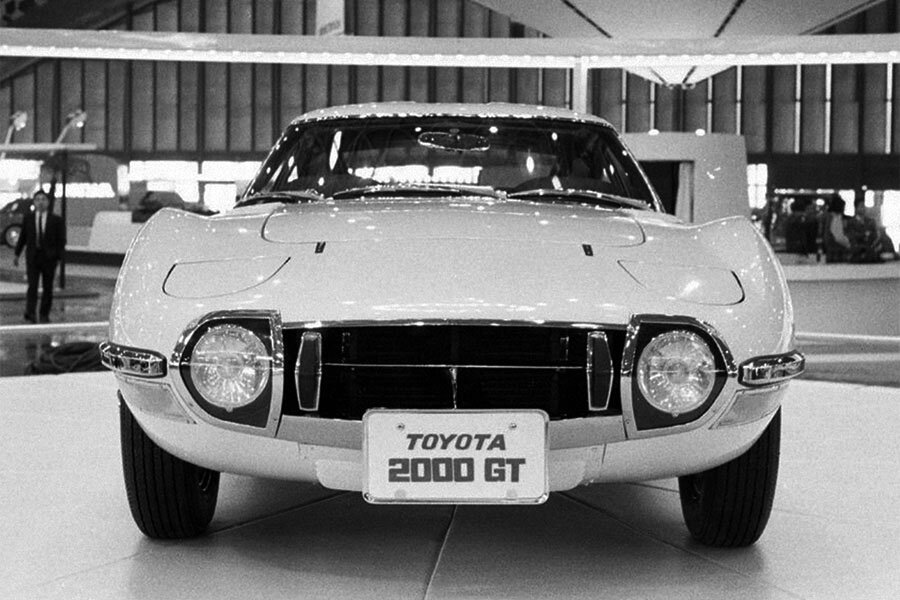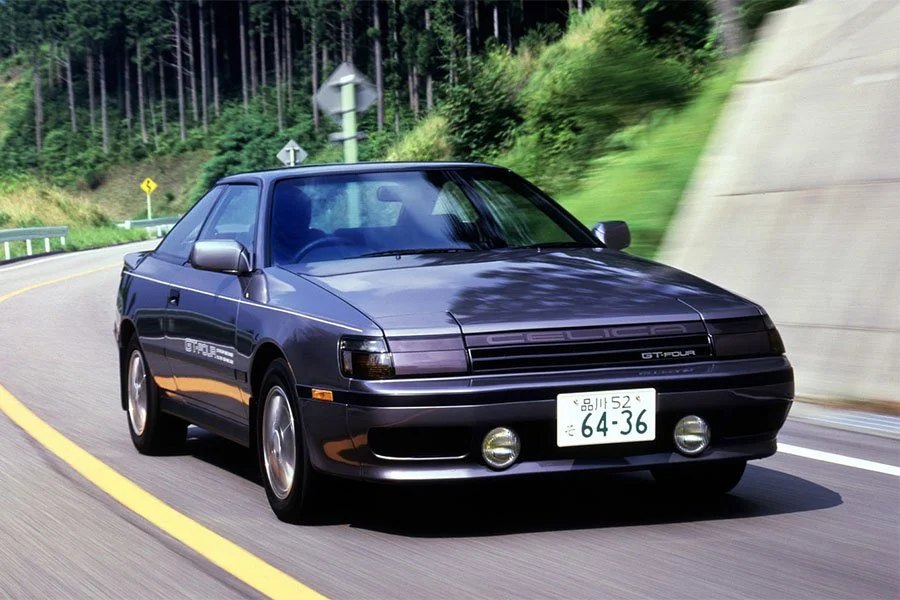Guide: Toyota 2000 GT - a Historical & Technical Appraisal
/BACKGROUND
In December 1964, the Toyota and Yamaha Motor Companies began a collaboration to produce a sleek high performance Coupe unlike anything yet seen from a Japanese manufacturer.
Toyota handled the overall layout and design for the car along with the basic parameters. Yamaha, under the direction of Toyota, was primarily responsible for improving engine performance and for detailed design of the body and chassis.
At the time, Yamaha had a considerable roster of clients in the automotive sector.
Yamaha’s concept to design and produce a powerful two-seat Gran Turismo was originally proposed to Nissan. With its pressed steel unibody construction, the A550X was envisaged as a mass production model. However, after a couple of prototypes, Nissan abandoned the idea.
Yamaha instead turned to Toyota, for whom they also did contract work.
Of all the Japanese auto makers, Toyota had a reputation as among the most conservative.
Wishing to improve their image, Toyota accepted Yamaha’s proposal, but made a series of fundamental changes to the specification.
Instead of a mass production model, Toyota wanted to build the finest sports car they possibly could. It was to be loaded with all the latest equipment, styled to match the best cars from Europe and built to an exceptionally high standard.
Despite the fact such a machine would cost considerably more than the A550X, Toyota still expected to sell around 1000 of the new cars every month.
Yamaha completed the first operational 2000 GT prototype in August 1965. The next month, they signed an agreement with Toyota to cooperate on production.
A second prototype was then displayed at the Tokyo Motor Show which opened in late October. Resplendent in white, the show-stopping 2000 GT took the Japanese automotive sector by storm, but was still far from production-ready.
Deliveries would eventually begin in April 1967.
The 20000 GT was built by Yamaha and sold through Toyota’s high end Toyota Store dealer network normally reserved for the firm’s large luxury saloons.
The 2000 GT was not the only sporting model in Toyota’s line up; earlier in 1965, production of the diminutive 790cc S800 had started.
Unlike the S800 micro car, the 2000 GT was a classic Gran Turismo: front-engined and rear wheel drive with a two-seat cockpit and handsome styling.
CHASSIS
Toyota rejected the original A550X’s unibody construction in favour of a Lotus-style backbone chassis.
Fabricated from steel, it was given a short 2320mm wheelbase and had the engine mounted as far back in the chassis as possible.
Toyota ultimately achieved an ideal 49% front and 51% rear weight distribution.
Suspension was independent all round via unequal length wishbones, coil springs and telescopic dampers. Anti-roll bars were fitted at either end.
Steering was non power-assisted rack and pinion type.
For the first time on a Japanese car, four-wheel power disc brakes were standard. The discs had an 11-inch diameter at the front and 10.5-inch diameter at the rear.
Wheels were 15 x 5-inch cast magnesium alloys with centre locking hubs and Dunlop Sport 500 tyres.
A 60-litre fuel tank was installed in the left-hand rear fender.
ENGINE / TRANSMISSION
The M-series straight six engine fitted to the 2000 GT was based on the flagship Toyota Crown powerplant.
In the pursuit of greater output, the Crown unit was substantially modified.
Most significant was the presence of a special Yamaha-designed aluminium twin cam head with wide 79° valves and hemispherical combustion chambers.
The switch from single to dual overhead camshafts resulted in an engine that developed more power, could rev much higher and breathe more easily.
The 2000 GT’s special 3M engine shared its cast-iron block with the rest of the M-range, but uniquely featured an aluminium sump plus a trio of twin-choke Mikuni-Solex 40 PHH carburettors.
It was longitudinally mounted in the chassis and displaced 1988cc thanks to a 75mm bore and stroke.
With compression set at a conservative 8.4:1, the 3M unit produced a peak output of 150bhp at 6600rpm and 129lb-ft at 5000rpm.
An all-synchromesh five-speed manual gearbox and limited-slip differential were fitted as standard.
Customers could choose from one of three different rear axle ratios to favour top speed or acceleration.
BODYWORK
Body styling was carried out by Toyota designer, Satoru Nozaki.
Nozaki created a low slung quintessentially Japanese Gran Turismo with a long hood, fastback cabin and well balanced proportions.
The car’s most distinctive feature was its front-end styling that, like the recently introduced S800, featured inboard lights mounted behind Plexiglas covers either side of the primary nose intake. However, on the 2000 GT, these covered lenses acted as the fog lights because the headlights were concealed beneath retractable pods located below the leading edge of the hood.
Minimalist bumpers were chrome-plated to match the front intake shroud, door handles, bezels, badges and window frames.
Bodywork on production cars was fabricated from aluminium.
INTERIOR
The well-equipped interior was comfortable but cramped by Western standards.
Black vinyl upholstery was used throughout with the seat centres given basket-weave centres.
The dash, steering wheel rim and gear knob were all given a rosewood veneer which contrasted nicely with the otherwise dark cabin.
A speedo and rev counter were located directly behind the three-spoke steering wheel. Five supplementary gauges were mounted centrally above an auto-seeking radio tuner.
Below the radio was the handbrake which owed its unusual position to the confined nature of the cabin.
WEIGHT / PERFORMANCE
Kerb weight was 1120kg.
Toyota quoted a top speed of 138mph and 0-62mph time of eight seconds.
PROTOTYPES
Around 15 to 20 prototypes were built before the start of production.
The prototypes fell into two categories: the 280 A / I and the 280 A / II.
The first 280A / I was completed by Yamaha in August 1965. Painted grey, it was sent for testing and evaluation, all of which proved extremely positive. In early October 1965, this car returned to Yamaha and was completely dis-assembled so the components could be inspected for fatigue.
The second 280 A / I prototype was painted white. This car was finished to a very high standard as it was destined for display at the forthcoming 1965 Tokyo Motor Show which opened in late October.
In total, six 280 A / I prototypes are understood to have been built, a couple of which wore steel bodies.
During 1966, two of the aluminium-bodied 280 A / Is were converted to 311 S competition specification. They were raced at the Japanese Grand Prix (May 3rd) where one car finished third and at the Suzuka 1000km (June 26th) where they finished first and second. The 311 S is covered separately.
At least five 280 A / II prototypes then followed, but few mechanical modifications were made. Instead, the most significant change was to re-position the A-pillars 40mm further forwards in an attempt to free up more cockpit space. This necessitated reworked doors and windows.
Other cosmetic changes affected the lighting, windscreen wipers and door handles while the service hatches down each flank were no longer lockable. At this stage, the 2000 GT was still riding on wire wheels.
One of the 280 A / IIs was exhibited at Tokyo Motor Show in October 1966.
Two were transformed into Spiders for use in the James Bond movie, For Your Eyes Only. These cars (covered separately) garnered Toyota considerable publicity for the 2000 GT, as did a series of World Speed Records that were set at the Yatabe high speed proving ground in October 1966.
PRODUCTION BEGINS
The first market-ready 2000 GT was completed in February 1967.
Deliveries began in April.
Production took place at Yamaha’s Iwata factory where each car was carefully assembled by hand.
Unfortunately, Toyota never made it close to their ambitious 1000 per month sales target. The 2000 GT was simply too expensive; it cost significantly more than a Porsche 911 or Jaguar E-type and Toyota still lost money on every car they sold.
PRODUCTION CHANGES
By 1969, Toyota were ready to try and stimulate sales.
The 2000 GT was given a facelift and, in order to reduce the price, a cheaper version with a single overhead camshaft engine was offered.
The 1969 facelift most notably included a modified front end for which both the primary intake and covered driving lights were re-shaped. Bigger front indicators and larger side markers were also fitted as a concession to export market regulations at the time.
Inside, new seats with separate adjustable head rests were added.
In an attempt to boost sales, Toyota began to offer the 2000 GT with a less expensive single overhead camshaft motor. Cars equipped as such were referred to as MF12 variants whereas the original DOHC two-litre derivatives were codenamed MF10.
To compensate for the retrograde step, Toyota opted for a bigger engine and fitted the Crown’s 2.3-litre 2M unit.
Slightly less powerful but a little torquier, the 2M engine displaced 2253cc thanks to a bore and stroke of 75mm and 85mm respectively. A trio of the Mikuni-Solex 40 PHH carburettors were installed.
In this configuration, the 2M engine produced 140bhp at 5400rpm and 148lb-ft at 3800rpm.
The first MF12 was completed in April 1969, but only a handful were built.
Toyota offered options for a three-speed automatic transmission and air-conditioning towards the end, but it made no difference; the 2000 GT had been a commercial failure.
Late 2000 GTs equipped with air-conditioning came with an additional scoop underneath the nose that fed air into the system.
END OF PRODUCTION
Production continued until October 1970 when the 2000 GT was discontinued without a successor lined up to take its place.
In total, 342 cars were built to MF10 specification with the original DOHC two-litre engine.
An additional nine MF12s were built with the 2.3-litre SOHC engine.
Text copyright: Supercar Nostalgia
Photo copyright: Toyota - https://global.toyota/





























